Korean literature
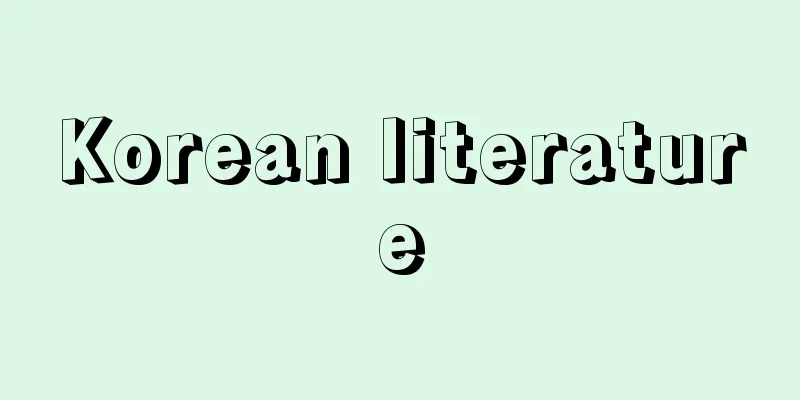
|
There are two streams of Korean literature. One is literature written in Hangul, and the other is Chinese literature written in Chinese characters. Hangul (Hunminjeongeum), the Korean language's native alphabet, was established in the middle of the 15th century, but all literature up until that point was written in Chinese characters. Even the Silla period folk songs (Kyōka/Hyangga) were written in the Ritō/Idō style, which uses the sounds and readings of Chinese characters to write Korean, like the Japanese Man'yōgana. Even after the creation of Hangeul, the development of Chinese literature in Korea continued until the beginning of the 20th century in parallel with the development of Hangeul literature. Some researchers have been of the opinion that these Chinese literature works should be excluded from the category of Korean literature, but the mainstream opinion is that these works, which are filled with the feelings and emotions of the people's daily life, are fine Korean literature and should be passed down as a heritage. Korea borders the Chinese mainland to the north and faces Japan across a strait to the south. From ancient times to modern times, Korea has been attacked from both sides, and has often been subjected to armed invasions. This also shows that Korea was exposed to the powerful and advanced waves of Chinese culture, and in modern times, it was eroded by Japanese culture due to Japanese colonization. Korean literature has maintained its unique vitality while being attacked from both sides. Therefore, its character has various shades. Some people see the distinctive feature of Korean literature in its resistance to foreign cultures and foreign characters, others in its "tenacity" and "politeness" (a subtle and delicate charm), others in its "resentment," others in its optimism, humor, and satire. [Yoon Hak Jun] Ancient literatureAround the time of Christ, over 70 tribal nations were formed and clustered on the Korean Peninsula. According to the Gishi Dongyi Zhuan (Records of the Eastern Barbarians of Wei) and other sources, after sowing seeds and harvesting, these tribes enthusiastically held rituals to worship the heavens, which consisted of drinking, singing and dancing. The primitive songs sung at these rituals are said to be the origins of Korean literature. Examples include the Kishika (Song of the Turtle). Ancient tribal nations were subsequently integrated, resulting in an era in which the three kingdoms of Goguryeo, Baekje, and Silla stood side by side. Various founding myths and legends were born in the process of the establishment of these nations, and these national epics can be roughly understood, for example, in the "Records of King Dongmyeong" written by the 12th century poet Yi Gyu-bo. In the preface to "Records of King Dongmyeong," Yi Gyu-bo states that he was moved by reading the "Annals of King Dongmyeong" in the "Old History of the Three Kingdoms" and reconstructed it to create the epic poem, which dynamically depicts the process of the founding of Goguryeo through the image of the hero Jumong. Each of the three kingdoms imported culture from the continent early on and developed their own unique culture, but as the culture took root, they were inspired to compile history books. According to records, in Baekje, the "Shuki" was compiled by a doctor named Goheung in 350, and around the same time in Goguryeo, the "Ryoki" was compiled, and in Silla, the "Kukshi" was compiled in 545. It is thought that these were integrated and reorganized into the "Old Three Kingdoms History," but these have all been destroyed, and their contents are unknown. However, by analogy with the relationship between the Yamato Imperial Court and the Japanese "Kojiki" and "Nihon Shoki," which were compiled in the early 8th century, it is easy to surmise that the series of history books on the Korean Peninsula were also national epics. This can also be seen from the fact that the founding myths and legends are handed down in the "Samguk Sagi" and "Samguk Yusa." After that, the three countries were unified by Silla, the country's national power grew, and its culture entered a period of maturity. Even though the means of expression was Chinese characters, they made it their own and formed a Chinese literature unique to Korea. Narrative literature such as "Kao Kai," "Cho Shin Mong Saeng," and "Kim Hyeon Gam Ho" were written during this period, as well as biographies such as "The Tale of an Eminent Sang" and "Hwarang Seong" by Kim Daemun. Among them, Choi Chiwon's "Kyeong Hyeon Bukkō" is a representative collection of poetry and prose from Unified Silla. The use of Chinese characters did not stop there, however, and the Koreans came up with a method known as Kyosatsu/Hyangchal, which combines on-yomi and kun-yomi. Similar to Japan's Man'yōgana, this method of writing made a great contribution to the development of Korean literature. This was evidenced by the compilation in 888 of a collection of Korean folk songs called "Sandaimoku" by the monk Daiku and others. This book of native Korean poetry has not been handed down to us, but 25 poems remain in "Samguk Yusa" and "Gyunyo Den." [Yoon Hak Jun] Literature of the Goryeo Dynasty (918-1392)During this period, local folk songs declined, while Chinese literature flourished. Goryeo's narrative literature seemed to have reached its zenith in the 12th and 13th centuries, when works such as the Records of the Three Kingdoms and the Annals of the Three Kingdoms were compiled. So-called "official novels" written in Chinese, such as Yi Inro's "Bakanji," Yi Gyubo's "Baekun shosetsu," Choi Ja's "Bokanji," and Yi Jaehyun's "Rikyou baizetsu," became popular. Poetry had fallen into a state of stagnation due to the decline of local folk literature, but after the Military Ministers' Rebellion in the mid-Goryeo period, a new style of poetry that expressed the feelings of the common people began to emerge. These were the "Goryeo folk songs" known as seonga, byeogyok, and jaengga. Many of these were free-spirited works that sang about nature and love, and their composers ranged from kings to monks and courtesans, but most of them were of the common people. For example, the song "Ssanghwa-deok" begins with the following lines: When I went to buy some manju at a manju shop, the owner of the shop shook my hand and said, "If this becomes a rumor inside and outside the shop, you little bastard, I think you said so. I'll go to your bed too. I've never seen such a terrible bed before..." (Translated by Tanaka Akira) [Yoon Hak Jun] Literature of the Yi Dynasty (1392-1910)The most notable event in the history of Korean literature is the establishment of the Korean alphabet, Hunminjeongeum (Kunminseong), or Hangeul. In 1443, King Sejong, the fourth king of the Yi dynasty (reigned 1418-50), established the Jeongeumcheong Office and mobilized many scholars, including Jeong Inji and Seong Sammun, to establish a phonetic alphabet consisting of 28 characters. After a three-year trial period, Hangeul was distributed in 1446, which brought about a great liberation in the linguistic life of the Korean people. In 1445, King Sejong ordered Jeong Inji and others to compose "Song of the Dragons Flying to Heaven" in the newly established Hangeul. This is a long poem (called a movement) that begins with the line, "The deeds of the six dragons of the east of the sea, soaring through the heavens, are all pleasing to the heavens..." and is a hymn praising the founding of the Yi dynasty. King Sejong himself also composed a song praising the achievements of Shakyamuni, "Song of the Moon Im and the Thousand Rivers." This shows King Sejong's extraordinary enthusiasm for Hangeul. King Sejong was a wise ruler who translated many Chinese classics, including the Four Books, and launched various cultural projects. Sijo, which appeared in the late Goryeo period, gained momentum with the emergence of Hangeul and developed rapidly. These include nostalgic songs by Gil Jae and Won Cheon Seok, loyalty songs by Seong Sammun and other "Six Dead Ministers," Maeng Sa Seong's "Gangho Sajiga" and Yi Hyon Bo's "Fisherman's Song." Other excellent poems that adorn the early Joseon period include love songs by female poet Hwang Jin Yi, which delicately sing of love between men and women, Neo-Confucian scholar Yi Hwang's "Tousan Jujiku" and Yi Ji's "Gosan Nine Songs." In the middle period, the refinement of poetic language progressed even further, reaching its zenith with Jeong Cheol and Yun Seon Do. Their series of works pursued the beauty and splendor of the Korean language to the utmost, and were so refined that they were said to represent the pinnacle of linguistic art. Kaji (poetry) was also popular. Whereas sijo is a short poem of three chapters and six lines, with around 45 characters, kaji is a long poem in verse form with prose-like content, continuing at length in a 3-4 or 4-4 rhythm. Jeong Keul-in's (1401-81) "Sangchun-gok" is the forerunner of kaji literature, but it was perfected by Jeong Cheol. Works such as "Kwantung-byeol-gok" and "Sibirin-gok," which skillfully recite landscapes, customs, and historical events from a tour of the Kanto region (the area east of Daegwallyeong in Gangwon-do, central Korea), can be said to be the pinnacle of kaji literature. The next kaji writer after Jeong Cheol was Park In-ro. In prose, we must mention Kim Si-su's "Kingo Shinhwa," the first collection of novels in Korea. This collection of works boldly depicts love between men and women, and strongly reflects the author's idea that we must be liberated from the curse of Confucianism, which ignored humanity. Other examples include Seo Geojeong's (1420-88) collection of poems and stories, "Dongin Shihwa," and, as examples of narrative literature, Eo Suk-kwon's (date of birth and death unknown) "Hiegwan Zaji" and Seong Hyeon's (1439-1504) "Yongjae Sohwa." These works had a significant influence on the novel literature that flourished in the late Joseon Dynasty. The two wars, the Imjin War (Bunroku-Keicho Invasion) and the Heisi Horan (Qing Invasion), which occurred from the end of the 16th century to the beginning of the 17th century, greatly changed the face of Korean literature. The Joseon dynasty is divided into early and late periods by these two wars, and while the literature of the early period was mainly the exclusive domain of the scholar-officials, the main writers of the later period were the common people. Sijo developed into the Jangga form of Saseollsijo, and Gaji developed into Naibanggaji, passing to women and common people. Pansori, which skillfully incorporated folk tales and attracted attention as a new genre of song drama, can be said to be the pinnacle of art for the common people. Pansori promoted the rise of Hangeul novels. Shin Jae-hyo, a representative pansori composer, organized and revised the pansori that had been passed down, establishing six repertoires. A representative work of novels that constitutes the mainstream of later literature is Heo Yun's "The Story of Hong Gildong." This is the first Hangul novel, a novel that rejects the feudal system and advocates change in reality, making it a monumental work in the history of Korean literature. Kim Man-joo's "Dream of Nine Clouds" and "Record of the Southern Expedition of Seo-sama" also attracted many readers. Novels reached their zenith during the reigns of Kings Yeongjo and Jeongjo (1725-1800). Some of his major works include "The Story of Chunhyang," "The Story of Simcheong," "The Story of Heungbu," and "The Story of the Rose and Red Lotus." There are also a series of short stories, including Park Ji-won's "Yangban Story," a novel written in classical Chinese. These works are permeated with scathing mockery and satire of the incompetent yangban rulers, and foreshadow the dawn of the modern era. [Yoon Hak Jun] Modern literatureThe normal development of modern Korean literature was hindered from its infancy by Japanese colonial rule. Therefore, while modern Korean literature rapidly absorbed various literary trends in the 50 years until liberation in 1945, it was always forced to shoulder the two tasks of modernizing the consciousness of the people and striving for national independence. Personal novels, which are based on a stable, petty-bourgeois consciousness, could not exist in modern Korea. At the end of the 19th century, modern Korean literature was pioneered by "songs," "new style poetry," and "new novels." Songs were written in 3-4 meter, 4-4 meter, 7-5 meter, and other formats, and sang of new ideas and new things. New style poetry was a kind of free prose poetry that began in 1908 and broke the conventional framework of songs, which were counted by the number of characters. New novels were a kind of enlightened political novel that existed for about 10 years from 1906, and actively promoted the spirit of autonomy and independence, patriotic ideas, new educational issues, women's issues, human rights issues, and so on. Representative writers include Yi In-jik and Yi Hae-jo (1869-1927). It is generally said that with these songs, new style poetry, and new novels as a precursor, full-fledged modern literature was pioneered in 1917 with Lee Kwang-soo's "Mujeong." Lee Kwang-soo and Choi Nam-seon, who dominated the early literary world, were supported by a strong national consciousness and a sense of enlightenment, and with a style that unified spoken and written language, they energetically introduced new knowledge and ideas to Korea, from the fields of social science to natural science. Around the time of the failure of the March 1st Independence Movement in 1919, literary magazines such as "Creation," "Ruins," and "White Cho" were launched one after another in rebellion against the enlightenment ideology of Lee Kwang-soo and others, and rejected utilitarianism. They advocated realism and romanticism, respectively, and sought to discover the self. Out of this emerged a literature that faced the real situation head on and showed a tendency towards reforming the existing order, which developed further and, riding on the rise of the world proletarian literature movement at the time, led to the formation of the Korean Proletarian Arts League (KAPF) in 1925. The League was forced to disband in 1935 due to Japanese oppression, but during the following ten years it engaged in literary activities that were the most courageous in resisting Japanese colonial rule. Representative writers include Yi Ki-young and Han Seol-ya, and poet Im Hwa. Meanwhile, the nationalist literary school, following the lead of Lee Kwang-soo and Yeom Sang-seop (real name Yeom Sang-seop), also formed itself by rejecting proletarian class consciousness. These two literary schools were in opposition to each other, and both confronted Japanese rule. However, after the Manchurian Incident in 1931, as Japanese rule became increasingly violent, both schools gradually avoided political involvement and took a step back. Then, with the influence of modernist literature, from the mid-1930s, "pure literature" gained power. Some pursued folk lyricism, some depicted the aesthetics of love, some described customs, and some entered the world of historical novels. However, during this period literature was internalized and writing was refined, resulting in works with a high artistic fragrance. When World War II began, along with the creation of surnames and the forced creation of writings in Japanese, which was called the "national language," the Writers' Association was organized, and some writers were forced to turn their hands to pro-Japanese literature. However, there were also poets such as Yi Yuk-sa and Yun Dong-ju, who stubbornly resisted to the end and died in prison. [Masuo Ohmura] North Korean literatureAfter liberation, Korea was divided into North and South, and literature followed separate paths of development for each. The main themes of North Korean literature were to visualize the anti-Japanese revolutionary struggle and the revolutionary struggle after liberation that succeeded it, and the dynamic reality of the socialist era. The creative method adopted was socialist realism, and a combination of ideology and artistry was required. Until the early 1960s, large-scale anthologies of modern Korean literature and complete works of world literature were published, and there was a relatively free atmosphere, but since 1965, the majority of works have been dedicated to the respect and affection of Prime Minister Kim Il-sung and his family, and despite the rapid expansion of writers and readers, there has been a tendency for novels and poetry to become somewhat rigid. Instead, large-scale "revolutionary operas" have achieved brilliant results. These operas are recent and original adaptations of works such as "Sea of Blood," "The Girl Who Sells Flowers," and "The Fate of a Member of the Self-Defense Forces," which were written during the anti-Japanese revolutionary struggle. Some of these operas require a performance of up to 1,000 people, including the choir, and have gained great popularity due to the simplicity of the lyrics and the innovative stage sets. In the 1980s and 1990s, "leader image literature," which depicts the deeds of two generations of leaders, Kim Il-sung and Kim Jong-il, reached its height of prosperity. The logic is that it is the natural duty of literature to worship and praise the leader of a country who has brought happiness to its people, but from the perspective of foreigners, this seems to have led to a rigidity in literature. On the other hand, however, there is a clear tendency to highly evaluate non-socialist literature, which was previously rejected, if it is conscientious nationalist literature, as seen in the introduction of Korean literature and the publication of a 100-volume collection of world literature, and it is certain that momentum for the unification of North and South Korea is growing in the literary field. [Masuo Ohmura] Korean (Republic of Korea) literatureIn the 38th parallel south of the country, where the left-wing camp had been gaining momentum immediately after liberation, left-wing literature completely disappeared after the establishment of South Korea in 1948. In the period of chaos following the armistice of the Korean War, the mainstream trend was for writers to seek the possibilities of life amid emptiness and extreme circumstances, and writers such as Son Chang-seop (1922-), author of "Letters in Blood" (1955), Kim Seong-han (1919-), author of "Five Minutes" (1957), and Seo Ki-won (1930-), author of "Map of the Dark Shooting" (1956), emerged. [Masuo Ohmura] 1960s-70sThe 1960s was a time of literary defiance against the setbacks of freedom. Although student and civic forces overthrew the Syngman Rhee regime, the following year in 1961 Park Chung-hee staged a coup d'état and established a military regime. The 1960s began with Choi In-hun's "The Square." This work criticizes both the individualism of the South and the schematicism of the North. The protagonist, Lee Myung-jun, was taken prisoner during the Korean War, but he did not want to be repatriated to his home country by either the South or the North, so he committed suicide by jumping off a building. Other representative writers of the 1960s include Lee Chung-jun (1939-2008), Kim Seung-ok (1941-), and Kim Ji-ha. Kim Ji-ha in particular stood up bravely to the military dictatorship with his critical spirit and satirical style, which he achieved through his exquisite use of language. Many of his works have been translated and published in Japan. In the 1970s, South Korea entered the industrialized society and achieved rapid economic growth. At the same time, the distortions of the economy also became apparent. Lee Mun-gu's (1941- ) "Essays on Gwangchon" (1977) is a series of novels that depict the impoverished rural areas in an industrialized society. Park Tae-sun's (1942- ) "On the Hill of My Beloved Village" (1973) also depicts the lives of residents on the outskirts of cities who are losing their livelihoods, and Cho Se-hee's (1942- ) "The Little Ball Launched by the Dwarfs" (1978) is the story of a family of five alienated factory workers. These novels depict the reality of rural areas and factories that are forced into inhuman conditions in the shadow of rapid economic growth. Another characteristic of the 1970s was the shift from a focus on short stories to a focus on long and medium-length novels. Representative examples of this are epic novels such as "The Land" (1969-1994) by Park Kyong-ri (1927-), which deals with national epic issues through the decline of a family over three generations from the late 19th century, and "Jang Gilsan" (1976-1984) by Hwang Sok-yong (1943-), which depicts the lowest class of society in the Joseon Dynasty (Yi Dynasty). [Masuo Ohmura] 1980sThe long era of military-turned-presidents, which had included Park Chung-hee, Chun Doo-hwan, and Roh Tae-woo, came to an end, and a civilian president was elected at the end of the 1980s. Literature calling for the restoration of human rights and democratization that had been suppressed during that time became the mainstream of literature in the 1980s. Another fruit of the 1980s was the appearance of epic novels that calmly reexamined the ideological conflict between North and South Korea, which had previously been considered taboo, as a national tragedy. Lee Tae's (1923- ) two-volume "The Southern Army" (1988) is a full-length memoir that records the Korean left-wing partisans who holed up in Jirisan during the Korean War. Cho Jeong-rae's (1943- ) epic novel "Taebaek Mountains" (completed in 1989) is a historical drama that covers the period from the founding of the Republic of Korea to the armistice of the Korean War (1948-53). This novel challenges the national policy that has existed since the founding of the Republic of Korea, which equates socialists with traitors to the nation, and presents through literature the task of objectively reexamining modern Korean history. [Masuo Ohmura] After the Seoul OlympicsThe 1988 Seoul Olympics marked Korea's arrival on the international stage. If the literature of the 1980s was militant literature calling for the restoration of human rights that had been suppressed, then the literature of the 1990s could be described as literature that had lost its ideological direction. The season of politics was over, and in a sense literature was regaining its original form. Expectations for the social role of literature faded, and the information age and commercialism became prominent, with detective novels and martial arts novels sections that had not previously existed in bookstores now taking up a large amount of sales floor space. In connection with this phenomenon, female writers came to the forefront of the literary world, such as Choi Yun (1953-), Shin Kyung-sook (1963-), and Gong Ji-young (1963-). Choi Yun's "Gray Snowman" (1992) portrays the oppression and scars suffered by young people during the Park Chung-hee era. Shin Kyung-sook's "Where the Organ Was" (1993) is a story of love that goes against social ethics, capturing the subtle emotions of longing and resentment. Kong Ji-young's "Go Alone Like a Rhino Horn" (1993) is a female protest against patriarchy. On the other hand, in terms of research and criticism, the 1990s saw the complete lifting of the ban on North Korean literature, and the liberalization of research and reprinting of materials, and we are now entering a stage where prospects for inter-Korean exchange and unification in the literary field are becoming more concrete. In the near future, a complete collection of unified literature, totaling 100 volumes, with 50 volumes for the South and 50 for the North, is scheduled to be published. [Masuo Ohmura] "History of Korean Literature" by Kim Sa-yeop and Jo Yeon-hyun (1971, Hokubosha)" ▽ "History of Korean Literature" by Kim Dong-woo (1974, NHK Publishing)" ▽ "History of Modern Korean Novels" by Kim Woo-jong, translated and annotated by Chang Jang-gil (1975, Ryukeishosha) " ▽ "History of Korean Literature" by Byeon Jae-soo (1985, Aoki Shoten)" ▽ "Study of Korean Women's Literature" by Aoyagi Yuko (1997, Ochanomizu Shobo)" ▽ "Modern and Contemporary Literature of Korea, edited by Lee Kwang-ho, translated by Yoon Sang-in and Watanabe Naoki (2001, Hosei University Press)" ▽ "Selections of Modern Korean Literature, edited and translated by Kim So-woon, 5 volumes (1973-76, Fuyukisha)" ▽ "Selections of Classical Korean Literature, translated by Hong Sang-gyu, 3 volumes (1975, Koryo Shoin)" ▽ "Selected Modern Korean Poetry" translated by Kang Shun, 5 volumes (1977-81, Ewha Publishing)" ▽ "Selected Modern Korean Novels" translated by Lee Seung-ok, 3 volumes (1978-85, Dongseonsha)" ▽ "Collection of 13 Contemporary Korean Writers by Furuyama Ko Ryo-oh (1981, Shinchosha)" ▽ "Selected Korean Short Stories, edited and translated by Omura Masuo, Naga Shokichi, and Saegusa Hisakatsu (1988, Iwanami Shoten)" ▽ "A 37-year magazine bibliography of Russian, Eastern European, Nordic, Latin, and Oriental literature, 1948-1984, edited and published by Nichigai Associates" ▽ "Poetry collection "Star of the Motherland" written by Go Eun and translated by Kim Hak-hyun (1989, Shinkansha)" ▽ "Shadow of Weapons, volumes 1 and 2, by Hwang Sok-yong, translated by Takasaki Soji et al. (1989, Iwanami Shoten) " ▽ "Selections of Contemporary Korean Poetry, translated and edited by Ibaraki Noriko (1990, Hana Jinja)" ▽ "Contemporary Korean Literature, edited by Kang Sang-kyu et al., all 6 volumes (1992, Kashiwa Shobo)" ▽ "Our Twisted Hero, by Lee Mun-yeol, translated by Fujimoto Toshikazu (1992, Information Center Publishing Bureau)" ▽ "Marriage, by Park Wan-ho, translated by Nakano Noriko (1992, Gakugei Shorin)" ▽ "Guardian of the Glass: A Collection of Short Stories by Korean Women Writers 1925-88," edited and translated by the Hen Association (1994, Kaifusha)" ▽ "Winter Illusions: A Collection of Works by Korean Women Writers," edited and translated by the Translation Association (1995, Asahi Culture Center)" ▽ "Taebaek Mountains" by Cho Jeong-rae, all 10 volumes (1999-2000, Homesha)" ▽ "Auntie Sun-i" by Hyun Ki-young, translated by Kim Seok-ho (2001, Shinkansha)" ▽ "Selected Korean Short Stories, volumes 1 and 2, edited and translated by Omura Masuo , Naga Shokichi, and Saegusa Hisakatsu (Iwanami Bunko)" ▽ "Sky, Wind, and Poetry" by Yun Dong-ju, translated by Ibuki Satoru (1984, Kageshobo) " ▽ "Reading Korea: Our Neighboring Country, edited by Yun Hak-jun, Kuroda Masahiro, and Sekigawa Natsuo (1986, Shueisha)" ▽ "Colonial Korean Literature Essays in Commemoration of the 60th Birthday of Dr. Otani Morishige and Shirakawa Yutaka (1992, Sugiyama Shoten) " ▽ "Colonial Korean Writers and Japan" by Shirakawa Yutaka (1995, University Education Publishing)" ▽ "Korean National Literature Theory: Seeking East Asian Solidarity" by Choi Ki-sik, translated by Aoyagi Yuko (1995, Ochanomizu Shobo) " "Yun Dong-ju Poetry Monument Construction Committee ed. "The Poet Who Sings the Stars: The Poetry and Research of Yun Dong-ju" (1997, Sangokan) " "Omura Masuo ed., "Learn the Korean Heart through Translations and Poetry" (1998, Seikyu Bunkasha)" [References] | | | | | |Kim |Choi Nam- | | | | | |Jeong Cheol| | | |Lee Ki-young| | | | |Source: Shogakukan Encyclopedia Nipponica About Encyclopedia Nipponica Information | Legend |
|
朝鮮の文学には二つの流れがある。一つはハングルで書かれた文学であり、いま一つは漢字で書かれた漢文学がそれである。朝鮮固有の文字であるハングル(訓民正音(くんみんせいおん))が制定されたのは15世紀のなかばだが、それまでの文学はすべて漢字によって表記された。新羅(しらぎ)時代の郷歌(きょうか/ヒャンガ)も、日本の万葉仮名のように、漢字の音と訓を借りて朝鮮語を表記した吏読(りとう/イドウ)式表記によって書かれている。 朝鮮における漢文学は、ハングルが制定されたのちも、ハングル文学の発展と並行し、20世紀初頭まで続けられた。一部の研究者の間には、これら漢文学を朝鮮文学の範疇(はんちゅう)から除外すべきだとの意見もあったが、民族の生活感情と情緒を盛ったこれらの作品はりっぱな朝鮮文学であり、遺産として継承すべきだとの主張が主流となっている。 朝鮮は、北は中国大陸と接し、南は海峡一つ隔てて日本と対峙(たいじ)する位置にある。古代から近代に至るまで朝鮮はこの南北からの挟撃にあい、しばしば武力侵攻を受けてきた。それはまた、強大かつ高度な漢文化の波にさらされていたことを示しており、近代以降は日本の植民地化による日本文化の侵食を受けたことを物語る。このように南北から挟撃を受けながら独特な生命力を維持してきたのが朝鮮文学である。したがって、その性格もさまざまな陰影をもっている。朝鮮文学の特色を、外来文化・外来文字に対する抵抗に置く人、あるいは「ねばり」と「慇懃(いんぎん/ウングン)」(そこはかとない細やかな情趣)にみる人、あるいは「恨(ハン)」だという人、楽天性と諧謔(かいぎゃく)・風刺性に求める人など、さまざまである。 [尹 學 準] 古代文学紀元前後、朝鮮半島には70余の部族国家が形成され群立していた。『魏志東夷伝(ぎしとういでん)』などによれば、種播(たねま)きのあとや刈り入れが終わるとこれらの部族では飲酒歌舞による祭天の儀式が盛んに行われたという。ここで歌われた原始歌謡が朝鮮文学の濫觴(らんしょう)をなすといわれる。『亀旨歌(きしか)』などがそれである。 古代の部族国家は、その後統合を重ね、高句麗(こうくり)、百済(くだら)、新羅の3国が鼎立(ていりつ)する時代となる。これらの国家が成立する過程でさまざまな建国神話や説話が生まれたが、これらの民族叙事詩は、たとえば12世紀の詩人、李奎報(りけいほう)によって書かれた『東明王篇(へん)』でおおよそうかがい知ることができよう。『東明王篇』は、李奎報が『旧三国史』の「東明王本紀」を読んで感動し、それを再構成してつくったと序文で述べているが、高句麗の建国過程を英雄朱蒙(チュモン)の形象を通してダイナミックに描いた叙事詩である。 3国はそれぞれ早くから大陸の文化を輸入し、独自の文化を形成していくのだが、文化が根を下ろすにしたがって史書編纂(へんさん)への意欲を刺激した。記録によると、百済では350年に高興という博士によって『書記』が編纂され、ほぼ同じころ高句麗でも『留記』が編まれ、新羅では545年に『国史』が編纂されたという。これらを統合し再編したのが『旧三国史』と思われるが、これらはことごとく隠滅して、その内容を知ることはできない。ただ、8世紀の初めに編纂された日本の『古事記』や『日本書紀』と大和(やまと)朝廷の関係から類推して、朝鮮半島の一連の史書もそれぞれ民族の叙事詩であったであろうことは容易に推察される。また、『三国史記』や『三国遺事』に建国神話や説話が伝承されているのをみても、それはわかる。 その後、新羅によって3国が統一され、国力が充実し、文化は爛熟(らんじゅく)期に入る。たとえ表現手段は漢字であるにせよ、それを自己のものにして朝鮮独自の漢文学を形成した。『花王戒(かおうかい)』や『調信夢生(ちょうしんむせい)』『金現感虎(きんげんかんこ)』のような説話文学や、金大問による『高僧伝』『花郎世紀(かろうせいき)』などの伝記類もこの時代に書かれた。なかでも崔致遠(さいちえん)の『桂苑筆耕(けいえんひっこう)』は統一新羅の代表的な詩文集である。 また、漢字の利用はそれにとどまらず、音と訓をあわせて使う吏読・郷札(きょうさつ/ヒャンチャル)という方法を考え出すようになった。日本の万葉仮名のようなものであるが、この吏読の表記法は朝鮮文学の発展に大きく寄与した。888年大矩和尚(だいくわじょう)らによって『三代目(さんだいもく)』という郷歌集が編纂されたのはその表れである。この朝鮮固有の詩歌を収めた同書はいま伝わっていないが、『三国遺事』『均如伝』に25首残っている。 [尹 學 準] 高麗時代(918~1392)の文学この時代に入ると郷歌が衰退し、漢文学はますます隆盛した。高麗(こうらい)の説話文学は『三国史記』『三国遺事』などが編纂された12、13世紀ごろには絶頂に達した感があった。李仁老(りじんろう)の『破閑集(はかんしゅう)』、李奎報の『白雲小説』、崔滋(さいじ)の『補閑集(ほかんしゅう)』、李斉賢(りさいけん)の『櫟翁稗説(れきおうはいぜつ)』など、漢文によるいわゆる稗官(はいかん)小説が流行したのである。 郷歌文学の衰退によって停滞状態に陥っていた詩歌も、高麗中期の武臣の乱以後、庶民階級の感情を盛った新しい形式の詩歌が出てきた。俗歌、別曲、長歌とよばれる「高麗歌謡」がそれである。これは、自然を歌い、恋を歌うという自由奔放なものが多く、作者は国王から僧侶(そうりょ)、遊女までという幅広いものであるが、その多くはやはり庶民階級であった。たとえば『双花店(そうかてん)』という歌謡は次のような句で始まる。 饅頭(まんじゅう)屋に饅頭買いに行ったら/回回(フエフエ)のおやじが私の手を握っただ/そしておやじの言うことにゃ/「これが店の内外(うちそと)でうわさになれば/小さいお前 小役者め/お前が言うたと思うぞよ/お前の寝床にわしも行く/こげなひどい寝床は見たことない……」(田中明訳) [尹 學 準] 李朝時代(1392~1910)の文学朝鮮文学史上特記すべきことは、なんといっても朝鮮の文字、訓民正音(くんみんせいおん)=ハングルの制定である。1443年、李朝第4代王世宗(せいそう)(在位1418~50)は、正音庁を設置し、鄭麟趾(ていりんし)、成三問(せいさんもん)ら多くの学者たちを動員して、28字からなる表音文字を制定した。ハングルはそれから3年間の試用期間を経て46年に頒布されたが、これによって朝鮮民族の言語生活は大きく解放された。 1445年世宗は、鄭麟趾らに命じて、新しく制定したハングルで『龍飛御天歌(りゅうひぎょてんか)』をつくらせた。これは「天翔(あまか)くる海東の六竜が業(わざ)は すべて天の嘉(よみ)するもの……」という句で始まる長編詩歌(これを楽章という)で、李王朝の創業をたたえる頌詠(しょうえい)歌である。世宗自らも釈尊の功績をたたえる歌『月印千江之曲(げついんせんこうのきょく)』をつくった。ハングルに対する世宗の並々ならぬ意気込みがうかがえる。世宗は英明な君主で、四書をはじめ多くの漢籍を翻訳したほか、さまざまな文化事業をおこした。 高麗末期に登場した時調(じちょう/シジョ)は、ハングルの出現に勢いを得て急速な発展を遂げた。吉再(きっさい)、元天錫(げんてんしゃく)らの懐古歌や、成三問ら「死六臣」たちの忠節歌、孟思誠(もうしせい)の『江湖四時歌』、李賢輔(りけんぽ)の『漁父詞』などがあり、男女の情愛を細やかに歌った女流詩人・黄真伊(こうしんい)の相聞歌、性理学者・李滉(りこう)の『陶山十二曲』、李珥(じ)の『高山九曲歌』などは李朝前期を飾る優れた詩歌である。中期になると、詩語の洗練が一段と進み、鄭澈(ていてつ)や尹善道(いんぜんどう)に至って絶頂に達した。彼らの一連の作品は、朝鮮語の美しさ、華麗さを極限にまで求めたものであり、言語芸術の極致といわれるほど磨かれたものだった。 歌辞(かじ/カサ)も盛んだった。時調が三章六句体、45字内外の短歌であるのに対して、歌辞は韻文形式に散文的な内容を盛ったもので、三四調、または四四調の音律で延々と続く長歌である。丁克仁(ていこくじん)(1401―81)の『賞春曲』が歌辞文学の嚆矢(こうし)だが、鄭澈により大成された。関東地方(朝鮮半島中部江原道(こうげんどう/カンウォンド)の大関嶺以東の地域)を遊覧しながら風景や風俗、故事などを巧みに詠み上げた『関東別曲』『思美人曲』などは歌辞文学の白眉(はくび)といえる。鄭澈に続く歌辞作者としては朴仁老(ぼくじんろう)がいる。 散文では朝鮮最初の小説集である金時習(きんじしゅう)の『金鰲新話(きんごうしんわ)』をあげねばならない。これは男女間の恋を大胆に描くことで、人間性を無視した儒教の呪縛(じゅばく)から解放されねばならぬという作者の思想が色濃く投影された作品集である。また徐居正(じょきょせい)(1420―88)の詩話集『東人詩話』、説話文学として魚叔権(生没年代未詳)の『稗官雑記』、成俔(せいけん)(1439―1504)の『慵斎叢話(ようさいそうわ)』などがある。これらは李朝後期に開花した小説文学に著しい影響を与えた。 16世紀の終わりから17世紀の初めにかけて起きた壬辰倭乱(じんしんわらん)(文禄(ぶんろく)・慶長(けいちょう)の役)と丙子胡乱(へいしこらん)(清(しん)の侵入)の両乱は、朝鮮文学の様相を大きく変えた。この両乱を境に李朝を前期と後期に分けるが、前期の文学がおもに士大夫たちの専有物であったのに対し、後期文学のおもな担い手は庶民階級であった。時調は長歌の辞説時調(サソルシジョ)に、歌辞は内房歌辞(ないぼうかじ)として婦女子や庶民の手に移り展開していった。民間説話を巧みに取り入れ、新しいジャンルの唱劇として脚光を浴びたパンソリは、庶民芸術の極致といえるものである。このパンソリはハングル小説の隆盛を促した。パンソリの代表的な作者申在孝(しんざいこう)は、伝来のパンソリを整理、修正して六つのレパートリーに定着させた。 後期文学の主流をなす小説の代表的な作品は許筠(きょいん)の『洪吉童伝(こうきつどうでん)』である。これはハングル小説の嚆矢であり、封建制度を否定、現実の変革を主張した小説で、朝鮮文学史上金字塔的な作品である。また、金万重(きんまんじゅう)の『九雲夢(きゅううんむ)』『謝氏南征記(しゃしなんせいき)』も多くの読者をひきつけた。小説文学は英祖・正祖時代(1725~1800)になって最盛期を迎える。おもな作品をあげると、『春香伝』『沈清(しんせい)伝』『興夫(こうふ)伝』『薔花紅蓮(しょうかこうれん)伝』などがある。 また、漢文小説である朴趾源(ぼくしげん)の『両班(ヤンバン)伝』をはじめ一連の短編小説があるが、これらの作品は、無能な両班支配者たちに対する痛烈な揶揄(やゆ)と風刺で貫かれており、近代への幕開きを予兆している。 [尹 學 準] 近代文学朝鮮近代文学は日本の植民地支配によって揺籃(ようらん)期から正常な発展を阻害された。したがって、1945年の解放までわずか50余年の間に朝鮮近代文学はさまざまな文学思潮をめまぐるしく摂取しながらも、つねに民衆の意識の近代化と民族の独立とを希求するという二つの課題を担わざるをえなかった。安定した小市民意識のうえに成り立つ私小説のたぐいは朝鮮近代には存在しえなかった。 19世紀末葉、朝鮮の近代文学は「唱歌」と「新体詩」と「新小説」を先駆とする。唱歌は三四調、四四調、七五調などの形態で新思想・新事物を歌った。新体詩はいわば自由散文詩で、1908年に始まり、従来字数で数える唱歌の定型枠を打ち破ったものであった。新小説は1906年からほぼ10年間にわたって存在した一種の啓蒙(けいもう)的政治小説で、積極的に、自主独立の精神、愛国思想、新教育問題、婦人問題、人権問題などを鼓吹した。代表的作家に李人稙(りじんちょく/イインジク)、李海朝(りかいちょう/イヘジョ)(1869―1927)がいる。これら唱歌・新体詩・新小説を前史として本格的近代文学が1917年李光洙(りこうしゅ/イグァンス)の『無情』をもって切り開かれたとするのが一般的である。初期文壇を独占した李光洙、崔南善(さいなんぜん/チェナムソン)は、強烈な民族意識と啓蒙意識に支えられつつ、言文一致の文体をもって、社会科学から自然科学の分野に至るまで新しい知識と思想を精力的に朝鮮に紹介した。1919年の三・一独立運動挫折(ざせつ)の前後から、李光洙らの啓蒙主義に反旗を翻し、功利性を排除した文学雑誌『創造』『廃墟(はいきょ)』『白潮』が次々に創刊された。彼らはリアリズムとロマンチシズムをそれぞれ掲げ、自我の発見に努めた。 そうしたなかから現実の状況を直視し既成秩序の変革への傾斜を示す文学が現れ、それがさらに発展し、おりからの世界プロレタリア文学運動の高まりにのって1925年「朝鮮プロレタリア芸術同盟」略称カップ(KAPF)が結成される運びとなった。カップは日本の弾圧を受けて35年に解散せざるをえなくなったが、その10年間、日本の植民地支配にもっとも果敢に抵抗した文学活動を展開した。代表的作家に李箕永(りきえい/イギヨン)、韓雪野(かんせつや/ハンソルヤ)、詩人に林和(りんわ/イムファ)がいる。 一方、李光洙、廉想渉(れんそうしょう/ヨムサンソプ)(本名廉尚燮)らの流れに沿う民族主義文学派も、プロレタリア階級意識を拒否することを通じて自己形成していった。この二つの文学流派は相拮抗(きっこう)しつつ、ともに日本の支配と対峙(たいじ)した。だが1931年の満州事変以降、日本の支配がますます狂暴化してくると、この両者はしだいに政治的関与を避けて一歩後退した。そこへモダニズム文学の影響も加わって30年代なかばからは「純粋文学」が勢力を獲得する。ある者は土俗的リリシズム(叙情性)を追い、ある者は愛欲美学を描き、ある者は風俗描写に、ある者は歴史小説の世界に潜り込んだりした。しかしこの時期に文学は内面化され文章は彫琢(ちょうたく)されて、芸術的香気の高い作品が生まれた。やがて第二次世界大戦が始まると、創氏改名と並んで「国語」と称する日本語による創作が強要され、文人報国会が組織されて、心ならずも親日文学に手を染める文学者も現れたりしたが、最後まで頑強に抵抗して獄中死した李陸史(りりくし/イユクサ)、尹東柱(いんとうちゅう/ユンドンジュ)のような詩人もいた。 [大村益夫] 北朝鮮の文学解放後の朝鮮は南北に分断され、文学もそれぞれ別途の発展の道をたどる。北朝鮮の文学の主要テーマは、抗日革命闘争とそれを継承した解放後の革命闘争と、社会主義時代の躍動する現実とを形象化する二点にあった。創作方法としては社会主義リアリズムをとり、思想性と芸術性の結合が要求されている。1960年代前半までは大規模な現代朝鮮文学選集や世界文学全集のたぐいも出版され比較的自由な雰囲気があったが、65年以降は首相金日成(きんにっせい/キムイルソン)およびその肉親に敬愛の念を捧(ささ)げる作品が多数を占め、書き手と読み手の急速な膨張にもかかわらず、小説や詩部門ではやや硬直化現象がみられる。かわって輝かしい成果を収めているのは大型の「革命歌劇」である。抗日革命闘争の時期に創作された『血の海』『花を売る乙女』『ある自衛団員の運命』などの素材を近年独創的に歌劇化したもので、合唱団をあわせれば1000人の出演を要するものもあり、歌詞の平易さ、舞台装置の新くふうもあって、大衆的な人気を博している。 1980年代、90年代に入って、金日成、金正日(きんしょうにち/キムジョンイル)という親子二代の指導者の事蹟を形成化する「首領形象文学」が全盛を極めている。国民に幸福をもたらした一国の指導者を崇拝し称賛することは文学の当然の責務であるという論理であるが、外国人の目から見ると、そのために文学の硬直化がもたらされているようにも思われる。しかし一方では韓国文学の紹介をはじめ、100巻本の世界文学全集が出版されるなど、従来否定してきた非社会主義文学を、良心的な民族主義文学であればこれを高く評価する傾向が明白になっており、文学面での南北統一への気運が高まりつつあることも確かである。 [大村益夫] 韓国(大韓民国)の文学解放直後むしろ左翼陣営が勢いを得ていた北緯38度線以南では、1948年の韓国樹立後、左翼文学は完全に姿を消した。朝鮮戦争休戦後の混乱期には、虚無と極限状況のなかで生の可能性を求める作品傾向が主潮となり、『血書』(1955)の孫昌渉(そんしょうしょう/ソンチャンソプ)(1922― )、『五分間』(1957)の金声翰(きんせいかん/キムソンハン)(1919― )、『暗射地図』(1956)の徐基源(じょきげん/ソギウォン)(1930― )らが現れた。 [大村益夫] 1960~70年代1960年代は自由の挫折(ざせつ)に対する文学的挑戦の時代であった。学生・市民勢力が李承晩(りしょうばん/イスンマン)政権を打倒したにもかかわらず、翌1961年には朴正煕(ぼくせいき/パクチョンヒ)のクーデターが起きて、軍事政権が誕生した。 1960年代の幕開けは崔仁勲(さいじんくん/チェインフン)の『広場』から始まった。この作品は南の個人主義も北の図式主義もともに批判している。主人公李明俊(イミョンジュン)は朝鮮戦争のなかで捕虜になったが、南にも北にも本国送還を望まず、投身自殺してしまう。 そのほか60年代の代表的文学者として、李清俊(りせいしゅん/イチョンジュン)(1939―2008)、金承鈺(きんしょうぎょく/キムスンオク)(1941― )、それに金芝河(キムジハ)らをあげることができる。とくに金芝河はその批判精神と絶妙な言語駆使による諷刺(ふうし)性によって軍事独裁政権に果敢に立ち向かった。彼の作品は日本でも数多く翻訳出版された。 1970年代、韓国は産業化社会に突入し、急速な経済成長を遂げる。それと同時にそのひずみも露呈する。李文求(りぶんきゅう/イムング)(1941― )の『冠村随筆』(1977)は、産業化社会のなかで窮乏化していく農村の姿を描いた連作小説である。朴泰洵(ぼくたいじゅん/パクテスン)(1942― )の『いとしき里の丘の上』(1973)も、生活基盤を失っていく都市周辺住民の生活を描き、趙世煕(ちょうせき/チョセヒ)(1942― )の『こびとが打ちあげた小さなボール』(1978)は疎外された工場労働者一家5人の物語である。これらの小説は高度経済成長の陰で非人間的な状況に追い込まれている農村や工場の現実を描き出している。 1970年代のもう一つの特色は、短編小説中心から長編・中編が中心になっていったことである。19世紀末から三代にわたる一家の没落過程を通じて民族叙事詩的課題を扱った朴景利(ぼくけいり/パクキョンニ)(1927― )の『土地』(1969~94)、朝鮮王朝(李朝)社会の最下層民を描いた黄晳暎(こうせきえい/ホァンソギョン)(1943― )の『張吉山』(1976~84)などの大河小説が、その代表的例である。 [大村益夫] 1980年代朴正煕、全斗煥(ぜんとかん/チョンドファン)、盧泰愚(ろたいぐ/ノテウ)と長期間続いた軍人出身大統領時代も終わりを告げ、1980年代末には文民大統領が選出される運びとなる。その間、抑圧されてきた人権の回復と民主化を求める文学が、80年代文学の基調となった。また従来タブー視されてきた南北イデオロギーの抗争を、民族の悲劇として冷静に見つめ直した大河小説の出現も80年代の成果であった。李泰(りたい/イテ)(1923― )の『南部軍』上下2巻(1988)は、朝鮮戦争時に智異山(ちいさん/チリサン)に立てこもった韓国の左翼系パルチザンを記録した長編手記である。 趙廷来(ちょうていらい/チョジョンネ)(1943― )の大河小説『太白山脈』(1989完結)は、韓国成立から朝鮮戦争停戦(1948~53)までを扱った歴史ドラマである。この小説は社会主義者イコール民族裏切者という韓国建国以来の国是に異議を唱え、韓国現代史を客観的に再検討する課題を文学を通じて提示した。 [大村益夫] ソウル・オリンピック以降1988年のソウル・オリンピックを契機として韓国は国際舞台に登場した。80年代文学が抑圧されてきた人権の回復を求めた闘う文学だったとすれば、90年代文学は理念的方向性を失った文学といえる。政治の季節は去り、ある意味では文学本来の姿を取り戻したともいえる。文学の社会的役割に対する期待は遠のき、情報化と商業主義が突出し、書店でも従来存在しなかった推理小説や武侠(ぶきょう)小説のコーナーが大きな売場面積を占めるようになった。 こうした現象と関連して、女性作家が文学界の前面に躍り出た。崔允(さいいん/チェユン)(1953― )、申京淑(しんきょうしゅく/シンギョンスク)(1963― )、孔枝泳(こうしえい/コンジョン)(1963― )などがその代表格といえる。 崔允の『灰色の雪だるま』(1992)は朴正煕時代の若者が受けた抑圧と傷跡を描いている。申京淑の『オルガンのあった場所』(1993)は社会倫理からはみでた愛の話で、憧(あこが)れと恨みの微妙な感情をとらえている。孔枝泳『サイの角のように一人行け』(1993)は家父長制に対する女性の抗弁である。 一方、研究・評論の面で1990年代は北朝鮮の文学が全面解禁されて、研究や資料復刻も自由化され、いまや文学面での南北交流と統一への展望が具体化される段階を迎えようとしている。近年中にも南50巻北50巻の統一文学全集100巻本が出版予定されている。 [大村益夫] 『金思燁・趙演鉉著『朝鮮文学史』(1971・北望社)』▽『金東旭著『朝鮮文学史』(1974・日本放送出版協会)』▽『金宇鍾著、長璋吉訳注『韓国現代小説史』(1975・龍渓書舎)』▽『卞宰洙著『朝鮮文学史』(1985・青木書店)』▽『青柳優子著『韓国女性文学研究』(1997・お茶の水書房)』▽『李光鎬編、尹相仁・渡辺直紀訳『韓国の近現代文学』(2001・法政大学出版局)』▽『金素雲編・訳『現代韓国文学選集』全5巻(1973~76・冬樹社)』▽『洪相圭訳『韓国古典文学選集』全3巻(1975・高麗書林)』▽『姜舜訳『現代韓国詩選』全5巻(1977~81・梨花書房)』▽『李丞玉訳『現代韓国小説選』3冊(1978~85・同成社)』▽『古山高麗雄著『韓国現代文学13人集』(1981・新潮社)』▽『大村益夫・長璋吉・三枝壽勝編訳『韓国短篇小説選』(1988・岩波書店)』▽『日外アソシエーツ編・刊『ロシア・東欧・北欧・ラテン・東洋文学に関する37年間の雑誌文献目録 昭和23年~昭和59年』(1988)』▽『高銀著、金学鉉訳詩集『祖国の星』(1989・新幹社)』▽『黄晳暎著、高崎宗司他訳『武器の影』上下(1989・岩波書店)』▽『茨木のり子訳編『韓国現代詩選』(1990・花神社)』▽『姜尚求他編『韓国の現代文学』全6冊(1992・柏書房)』▽『李文烈著、藤本敏和訳『われらの歪んだ英雄』(1992・情報センター出版局)』▽『朴婉緒著、中野宣子訳『結婚』(1992・学芸書林)』▽『めんどりの会編訳『ガラスの番人――韓国女性作家短編集1925~88』(1994・凱風社)』▽『ほんやくの会編訳『冬の幻――韓国女性作家作品集』(1995・朝日カルチャーセンター)』▽『趙廷来著『太白山脈』全10巻(1999~2000・ホーム社)』▽『玄基栄著、金石範訳『順伊おばさん』(2001・新幹社)』▽『大村益夫・長璋吉・三枝壽勝編訳『朝鮮短篇小説選』上下(岩波文庫)』▽『尹東柱著、伊吹郷訳『空と風と詩』(1984・影書房)』▽『尹学準・黒田勝弘・関川夏央編『韓国を読む――こんなに知らないとなりの国』(1986・集英社)』▽『大谷森繁・白川豊著『大谷森繁博士還暦記念朝鮮文学論叢』(1992・杉山書店)』▽『白川豊著『植民地期朝鮮の作家と日本』(1995・大学教育出版)』▽『崔基植著、青柳優子訳『韓国の民族文学論――東アジアの連帯を求めて』(1995・お茶の水書房)』▽『尹東柱詩碑建立委員会編『星うたう詩人――尹東柱の詩と研究』(1997・三五館)』▽『大村益夫編訳『対訳・詩で学ぶ朝鮮の心』(1998・青丘文化社)』 [参照項目] | | | | | | | | | | | | | | | | | | | | | | | | | | | |出典 小学館 日本大百科全書(ニッポニカ)日本大百科全書(ニッポニカ)について 情報 | 凡例 |
Recommend
Red Fin - Red Fin
Please see the "Red Hook Muleus" page. ...
Suction funnel - Kyuinrouto
A general term for funnels used in vacuum filtrat...
Decapods - Decapods
A general term for crustaceans in the order Decapo...
Nagpur (English spelling)
A commercial and industrial city in the northeaste...
serekh
...The move of the capital from Thinis to Memphis...
Aji [town] - Aji
A former town in Kida County, occupying the tip of...
Squid cage fishing - Squid cage fishing
...These fishing methods are mainly applied to oc...
Legend of the Argonauts - Legend of the Argonauts
A Greek mythological story of an expedition and ad...
Kanazu [town] - Kanazu
A former town in Sakai County, straddling the Fuku...
Vegan Society
…In modern times, vegetarianism is supported not ...
Mutsuzawa [town] - Mutsuzawa
A town in Chosei County in the southeastern part o...
"Kusyaronsho"
…He lectured on the Mahabharata school's fund...
Seneca Falls Convention - Seneca Falls Convention
The first women's rights conference was held i...
North Noh Stage - Kitano Ubutai
...The stage style we see today is thought to hav...
Transcendentalism
The doctrine of doing things independently accordi...
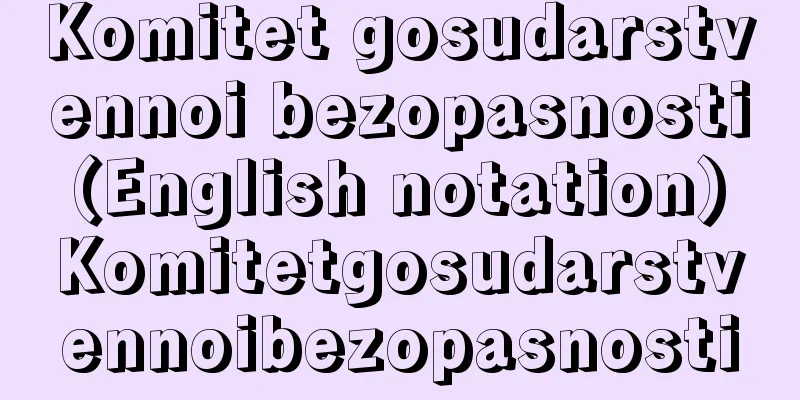

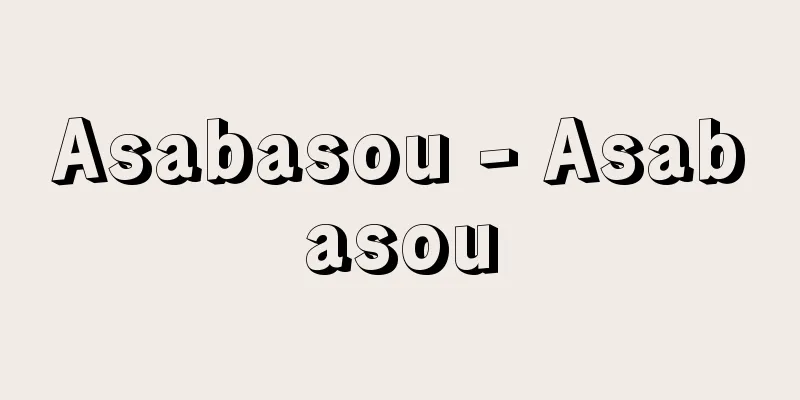


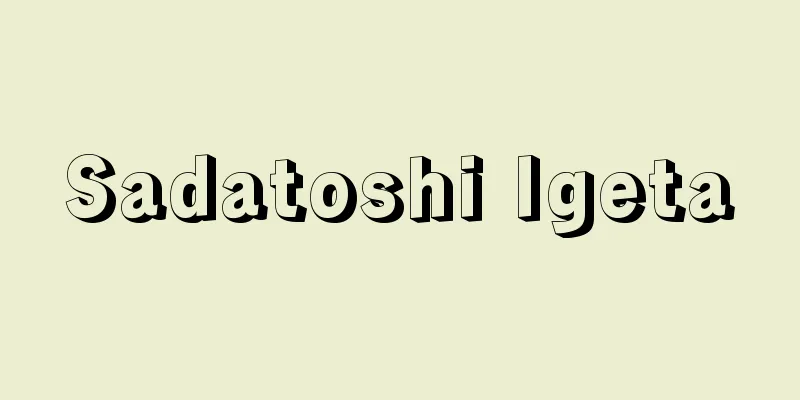

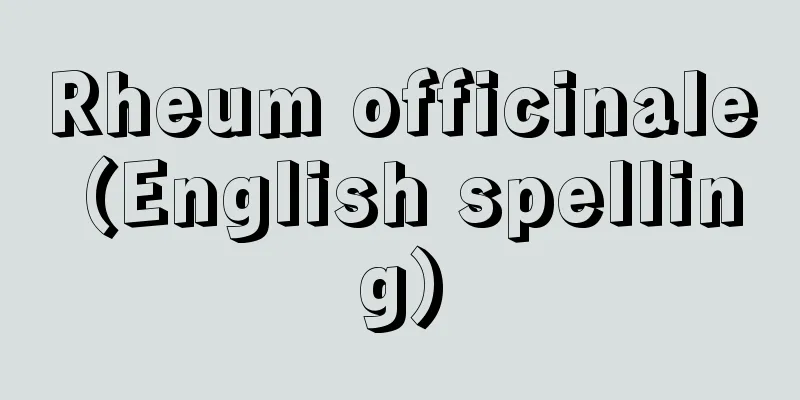
![Nishinoomote [city] - Nishinoomote](/upload/images/67cc6d2633db4.webp)
